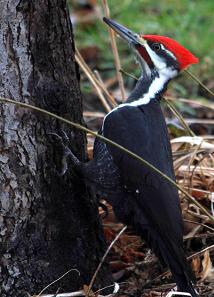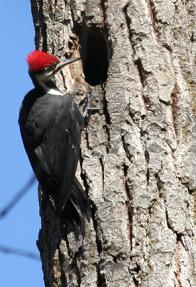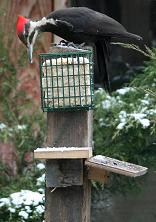Pileated Woodpecker 
Identification and Pictures
(Dryocopus pileatus)
Pileated Woodpeckers are very large
woodpeckers, about the  size of a crow, 16 to 19 1/2
inches. They are black with a bright
red crest from the beak to the back of the head. The
face has a red mustache, and a white bar goes across the face,
and extends down the neck. Males have a white line over
the eyes. They have a long, sharp, black bill,
with yellow bristly feathers over their nostrils that help keep out wood
chips. Their strong feet
allow them to cling on tree trunks. Females have a dark forehead,
and do not have the red mustache. In flight they can be
identified by the white under wing coverts, and sweeping wing
beats. size of a crow, 16 to 19 1/2
inches. They are black with a bright
red crest from the beak to the back of the head. The
face has a red mustache, and a white bar goes across the face,
and extends down the neck. Males have a white line over
the eyes. They have a long, sharp, black bill,
with yellow bristly feathers over their nostrils that help keep out wood
chips. Their strong feet
allow them to cling on tree trunks. Females have a dark forehead,
and do not have the red mustache. In flight they can be
identified by the white under wing coverts, and sweeping wing
beats.
Photos by Keith
Lee. The camera I use is the Canon
EOS 40D. Visit All-birds store
You may see a Pileated
woodpecker as it flies from tree to tree searching for
insects. When it
detects a grub beneath the bark it will begin its slow
methodic hammering. The head swings in a large ark,
chips fly as the bill smashes into the tree like a
sledge-hammer with a force that you might think would break
its neck. When the hammering stops he will probe the
hoes with his pointed, spear like tongued until he gets his meal. His
extremely long tongue ends in a horny, barbed tip, and can be
used to impale prey.

Pileated Woodpecker sounds
Their call sounds much like the flicker's call,
but louder. They also have a ringing call that rises and
falls. In addition to the sound they make digging for
insects in trees, they drum on hollow trees to claim
territory, making loud drumming sounds that can heard for long
distances. They use this drumming to attract mates, and
to define their territories. Sound
sound 2
Preferred Habitat
Pileated woodpeckers can be found across
Canada, and in eastern and western U.S. They usually
remain resident, and defend their territory year round.
They like mature wooded coniferous, and deciduous forests that contain a lot of dead trees.
They will also reside in city parks and golf courses.
Breeding and Nesting

Pileated Woodpeckers mate for life. For
a nest both birds excavate a large cavity a in a tree.
The nest will often have more than one entrance, giving them
an extra escape route in case of predators. They will
peck the bark around the hole to get sap running. The
sap helps keep predators away from the nest. These
woodpeckers will excavate a new cavity each year providing
cavities for other birds to use. They will also nest in
nest boxes. See birdhouse
dimensions for building plans.
The females will lay 3 to 5 white eggs.
Both parents will incubate the eggs for about 2 weeks, and the
young birds will fledge in roughly a month. The parents
continue to feed, and teach the young birds how to forage for
several months after they fledge. The young birds will
leave the parents in the fall, and establish their own
territories in the spring.
Food
 These
woodpeckers eat insects such as ants, and beetle larvae, as well
as nuts, and berries. They pull the bark off of trees, and
chip out large holes in trees with their long sharp bill,
searching for insects. They have a long sticky tongue
they stick in holes to pull out ants. They also forage
on the ground. They will also visit suet feeders in back
yards. These
woodpeckers eat insects such as ants, and beetle larvae, as well
as nuts, and berries. They pull the bark off of trees, and
chip out large holes in trees with their long sharp bill,
searching for insects. They have a long sticky tongue
they stick in holes to pull out ants. They also forage
on the ground. They will also visit suet feeders in back
yards.
The Pileated Woodpecker was the inspiration for
the cartoon character Woody Woodpecker.
Watch video of Pileated woodpecker taking a
bath in a stream below
For more on food
and feeding birds click here.
For more on feeders click here.
To learn about other favorite
birds click here.

|
